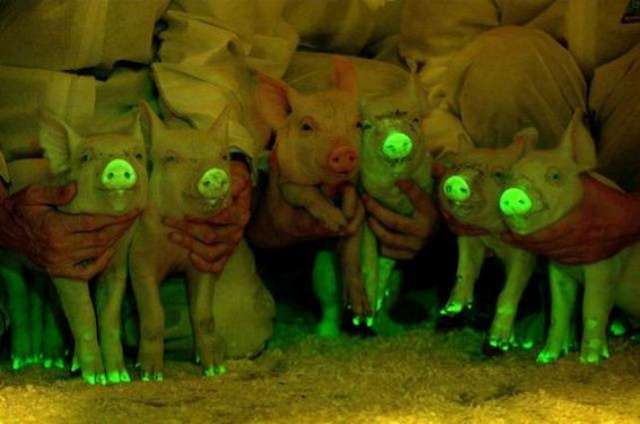Glow-in-the-dark piglets born
As the new year rolls in, so does the prospect of glow-in-the-dark bacon and neon pork chops. Last August, two researchers at the South China Agricultural University in Guangdon Province—Zhenfang Wu and Zicong Li—successfully injected biofluorescent genetic material taken from jellyfish directly into pig embryos, resulting in the birth of 10 transgenic pigs that glow when subjected to ‘black’ or ultraviolet light. Although the idea of glowing food is more of a joke than a serious prospect, Wu and Li intend for this research to serve a very practical application. The scientists explained to CBC that the method may be used to create more efficient and less costly medicines for humans suffering from many types of ailments.
“Patients who suffer from hemophilia need blood-clotting enzymes in their blood. We can make those enzymes a lot cheaper in animals rather than a factory that will cost millions of dollars to build,” explained Stefan Moisyadi, a bioscientist at the University of Hawaii’s Institute for Biogenesis Research—home to where this technique was originally developed.
“[The green glow] is just a marker to show that we can take a gene that was not originally present in the animal [which] now exists in it,” Moisyadi said.
Wu and Li are not the only researchers to investigate transgenic animals. Scientists all over the globe are pioneering this technique. Scientists in Turkey used the same method to create the world’s first glow-in-the-dark rabbits, and they are currently working to create a glowing sheep.
A spoonful of sugar makes the migraine go down
A study published this January in Science Translational Medicine concluded that placebo pills have strong enough therapeutic effects to reduce patient symptoms—even when they know they are consuming sugar pills.
Professor of Medicine at Harvard University Ted Kaptchuk performed an experiment using the same 66 patients for each test. The patients first experienced a migraine attack without treatment. During six subsequent attacks, they were either given the migraine drug Maxalt or a placebo pill. Kaptchuk reported that patients experienced significant pain relief, compared to the untreated migraine attack, even when they knew they had swallowed nothing more than a sugar pill.
While the American Medical Association (AMA) considers the use of placebos without a patient’s consent to be “bad medicine,” Kaptchuk’s results suggest that in the future, labeled placebos could be used to treat conditions like migraines.
Kaptchuk is not the only researcher to investigate the beneficial use of placebos. Italian neuroscientist Fabrizio Benedetti demonstrated in neuroimaging studies that placebos might play a role in changing the circuitry and chemistry of the brain in a similar fashion to certain medications. Other studies have shown that placebos induce the release of opioids—a chemical produced by the brain to relieve pain.
Although Kaptchuk’s results need to be reproduced by other researchers before “open-label” placebos are put into practice, his studies show promise in the field of placebos.









